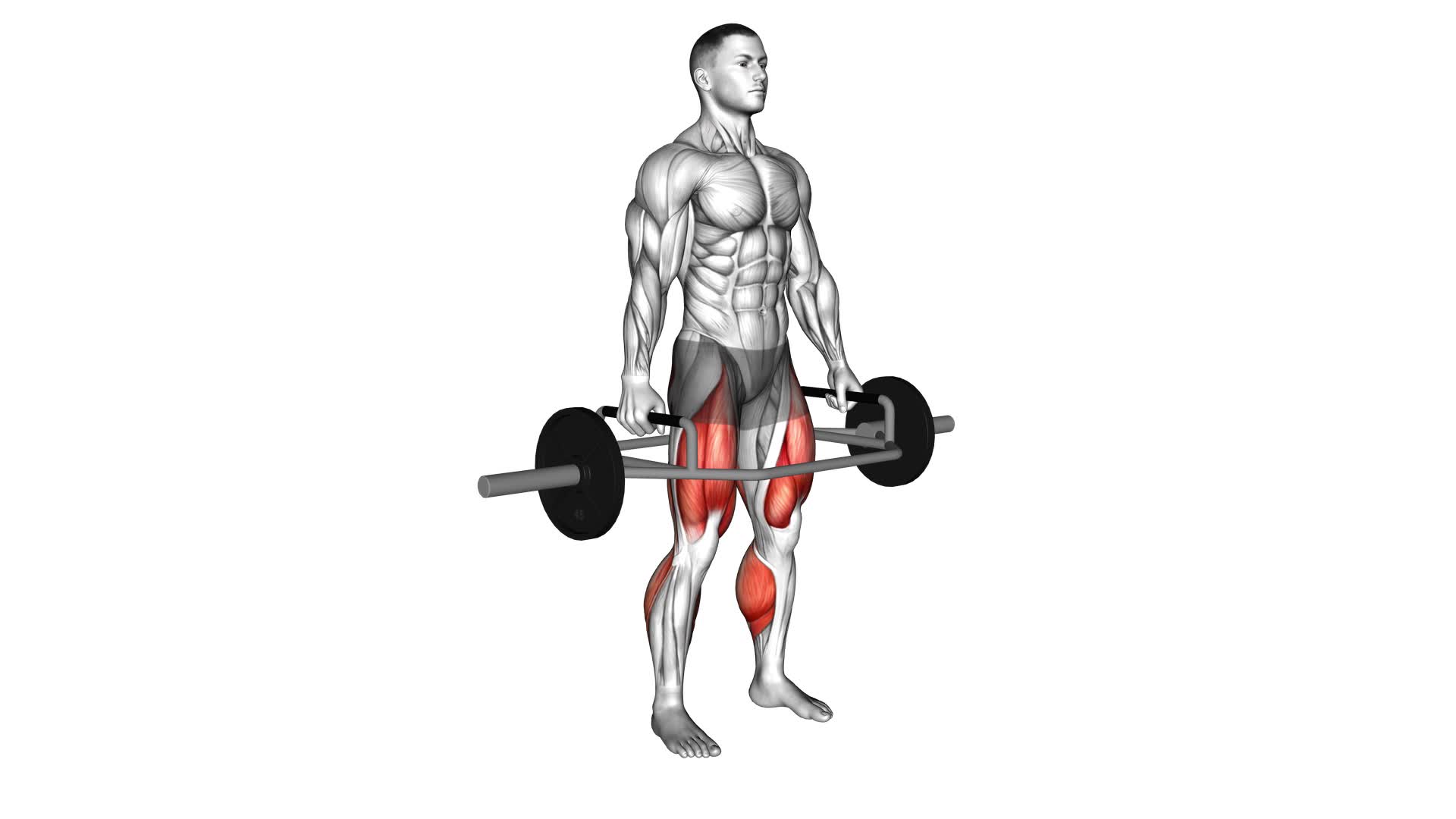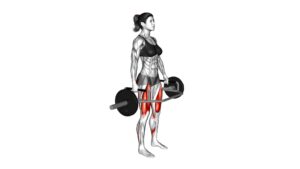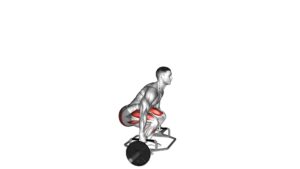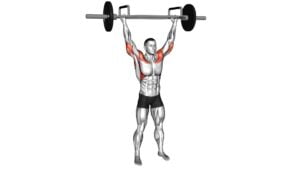Trap-Bar Deadlift – Video Exercise Guide & Tips

Looking to add a new exercise to your routine? The trap-bar deadlift is a great choice.
Watch This Exercise Video
This video exercise guide and tips will show you the proper form and technique to get the most out of this exercise. Avoid common mistakes and learn variations and progressions to keep challenging yourself.
Maximize your results with these helpful tips. Get ready to elevate your workout with the trap-bar deadlift.
Key Takeaways
- Trap-bar deadlifts target multiple muscle groups simultaneously
- Trap-bar deadlifts are highly effective for injury prevention
- Trap-bar deadlifts engage lower body muscles, including glutes, hamstrings, and quadriceps
- Trap-bar deadlifts strengthen core muscles, improving balance and posture
Benefits of the Trap-Bar Deadlift
One of the key benefits of the trap-bar deadlift is that it targets multiple muscle groups simultaneously. This exercise is highly effective for injury prevention as it engages the muscles in your lower body, including your glutes, hamstrings, and quadriceps. By strengthening these muscles, you can enhance stability and support for your joints, reducing the risk of injuries such as strains or tears.
Additionally, the trap-bar deadlift also activates your core muscles, including your abdominals and lower back, which helps to improve your overall balance and posture.
To incorporate the trap-bar deadlift into your workout routine, you can start with a sample workout that includes three sets of eight repetitions. Begin by standing inside the trap-bar with your feet shoulder-width apart. Bend your knees and grab the handles of the trap-bar, keeping your back straight and your chest up. From this starting position, push through your heels and extend your hips and knees to lift the trap-bar off the ground. Pause briefly at the top and then lower the trap-bar back down to the starting position. Remember to engage your core and maintain proper form throughout the exercise.
Proper Form and Technique
To perform the trap-bar deadlift with proper form and technique, follow these guidelines:
- Start by standing in the center of the trap bar with your feet shoulder-width apart.
- Bend at your knees and hips to lower your body down, keeping your back straight and your chest up.
- Grip the handles of the trap bar with an overhand grip, ensuring that your hands are shoulder-width apart.
- Engage your core and push through your heels as you lift the trap bar, extending your hips and knees until you're standing upright.
By following these guidelines, you can ensure proper form and technique while performing the trap-bar deadlift. This is crucial for injury prevention and maximizing results. Maintaining a straight back and proper alignment throughout the lift helps to protect your spine and reduces the risk of strains or sprains. Engaging your core and using your lower body muscles effectively will allow you to lift heavier weights and target the intended muscle groups more efficiently.
Now that you have learned the proper form and technique for the trap-bar deadlift, it's important to be aware of common mistakes to avoid.
Common Mistakes to Avoid
To perform the trap-bar deadlift correctly, it's important to avoid common mistakes that can lead to injury.
First, make sure to maintain proper form throughout the exercise, keeping your back straight and engaging your core.
Secondly, be mindful of your technique, ensuring that you're using your legs and hips to lift the weight, rather than relying on your back.
Lastly, follow injury prevention tips such as starting with lighter weights, gradually increasing the load, and listening to your body to avoid overexertion.
Proper Form Demonstration
To ensure proper form during trap-bar deadlifts and avoid common mistakes, focus on maintaining a strong and stable core throughout the exercise. This will help you prevent injuries and maximize the effectiveness of your workout. Here are some key points to keep in mind:
- Start with your feet shoulder-width apart and toes slightly pointed out.
- Grip the handles of the trap bar with an overhand grip, keeping your arms straight.
- Engage your core and hinge at the hips, lowering your body down while keeping your back flat.
- Push through your heels and drive your hips forward to stand back up, maintaining a neutral spine.
By following these guidelines, you can ensure proper form and reduce the risk of injury.
Now, let's move on to common technique errors that you should avoid.
Common Technique Errors
What are some common mistakes you should avoid when performing trap-bar deadlifts?
Proper setup and grip strength are crucial for a successful lift. One common mistake isn't setting up properly before lifting. Make sure your feet are shoulder-width apart, with the bar centered between your feet.
Another mistake isn't having a strong grip. Your grip should be firm, but not overly tight, to prevent the bar from slipping.
It's important to avoid rounding your back during the lift, as this can put excessive strain on your spine.
Lastly, avoid using your lower back to lift the weight. Instead, engage your leg and hip muscles to generate power and lift the bar.
Injury Prevention Tips
To prevent injuries and avoid common mistakes, focus on maintaining proper form and technique when performing trap-bar deadlifts. Here are some injury prevention tips to keep in mind:
- Perform injury prevention exercises: Strengthening your core, glutes, and hamstrings can help support your body during the deadlift movement and reduce the risk of injury.
- Warm up properly: Before starting your trap-bar deadlifts, make sure to warm up your muscles and joints with dynamic stretches and light cardio exercises. This will increase blood flow and prepare your body for the workout.
- Use appropriate weight: Gradually increase the weight as you become more comfortable and confident with your form. Using excessive weight can put unnecessary strain on your muscles and increase the risk of injury.
- Listen to your body: If you experience any pain or discomfort during the exercise, stop immediately and consult a professional to avoid further injury.
Variations and Progressions
As you progress in your trap-bar deadlift training, you can incorporate variations to challenge your muscles in different ways.
Variations and progressions can help you continue to improve your technique and form, as well as maximize your results.
One variation you can try is the deficit trap-bar deadlift, which involves standing on a platform or weight plates to increase the range of motion and target your muscles differently.
Another variation is the single-leg trap-bar deadlift, where you perform the exercise on one leg to improve stability and balance.
Additionally, you can experiment with different grips, such as the double overhand grip or the mixed grip, to challenge your grip strength and engage your muscles in different ways.
Progressions can also be made by gradually increasing the weight you lift or the number of repetitions you perform.
By incorporating variations and progressions into your trap-bar deadlift training, you can continuously challenge your muscles and see continued improvements in your strength and overall fitness.
Now, let's move on to the next section for tips on maximizing your results.
Tips for Maximizing Results
To maximize your results, focus on proper form and technique during your trap-bar deadlift workouts. Here are some tips for maximizing gains and implementing effective training techniques:
- Maintain a neutral spine: Keep your back straight throughout the exercise to prevent injuries and engage the correct muscles.
- Engage your core: Contract your abdominal muscles before initiating the movement to provide stability and support for your spine.
- Push through your heels: Drive the weight up through your heels, rather than your toes, to activate the posterior chain and maximize power.
- Gradually increase weight: Start with a weight that allows you to maintain proper form and gradually increase the load as you become stronger and more proficient.
By following these tips, you can ensure that you're getting the most out of your trap-bar deadlift workouts. Remember, proper form and technique are essential for maximizing gains and preventing injuries.
Incorporate these effective training techniques into your routine and watch your strength and muscle mass increase over time.
Sample Trap-Bar Deadlift Workout
Now let's talk about the benefits of incorporating trap-bar deadlifts into your workout routine.
You'll learn about the proper form and technique to maximize your results and reduce the risk of injury.
Additionally, we'll explore variations and progressions that can help you continue challenging your muscles and making progress over time.
Benefits of Trap-Bar Deadlifts
Experience the numerous benefits of trap-bar deadlifts and incorporate them into your workout routine with this sample trap-bar deadlift workout. Trap-bar deadlifts offer several advantages that can help in injury prevention and maximizing results.
Benefits of trap-bar deadlifts include:
- Reduced strain on the lower back: The trap-bar design allows for a more upright torso position, reducing stress on the lower back and decreasing the risk of injury.
- Increased muscle activation: Trap-bar deadlifts target multiple muscle groups, including the glutes, hamstrings, quadriceps, and traps, resulting in overall strength and muscle development.
- Improved grip strength: The trap-bar's neutral grip handles engage the forearm muscles, improving grip strength and reducing the likelihood of dropping the weight.
- Versatility: Trap-bar deadlifts can be modified to suit different fitness levels and goals, making them suitable for beginners and advanced lifters alike.
Incorporate trap-bar deadlifts into your routine to reap these benefits and enhance your overall strength and fitness.
Form and Technique Tips
Maximize your trap-bar deadlift performance with proper form and technique.
To maximize gains and prevent injuries, it's crucial to focus on a few key aspects.
First, start by positioning your feet shoulder-width apart, with your toes pointed slightly outward. This will provide a stable base and allow for optimal force production.
As you lower your body down, keep your chest up and maintain a neutral spine. Avoid rounding your back, as this can put excessive stress on your lower back.
Engage your core and activate your glutes throughout the movement.
Finally, make sure to lift the weight using your legs and hips, rather than relying on your back.
Following these form and technique tips will help you get the most out of your trap-bar deadlifts while minimizing the risk of injury.
Variations and Progressions
To continue exploring the trap-bar deadlift and its variations and progressions, let's delve into a sample trap-bar deadlift workout. This workout will help you build strength and improve your technique while incorporating variation and progression.
Here are some key elements to include in your trap-bar deadlift workout:
- Start with the basic trap-bar deadlift to establish proper form and technique.
- Increase the weight gradually as you become more comfortable and confident.
Incorporate tempo variations, such as:
- Slow eccentric (lowering) phase to challenge your muscles in a different way.
- Explosive concentric (lifting) phase to increase power and explosiveness.
Implement injury prevention techniques:
- Maintain a neutral spine throughout the exercise to protect your back.
- Engage your core muscles to provide stability and support.
- Use proper breathing techniques to maintain control and prevent injury.
Frequently Asked Questions
Is the Trap-Bar Deadlift Suitable for Beginners or Should It Only Be Performed by Experienced Lifters?
The trap-bar deadlift can be suitable for beginners as well as experienced lifters. It offers beginner-friendly modifications that can help you learn the proper form and technique.
This exercise is beneficial for muscle growth as it targets multiple muscle groups, including the legs, hips, and back.
Incorporating the trap-bar deadlift into your routine can help you build strength and improve your overall fitness level.
Can the Trap-Bar Deadlift Help Improve Grip Strength?
The trap-bar deadlift is a great exercise for improving grip strength. By using a trap bar, you can engage your hands and forearms more effectively, helping to develop a stronger grip.
This exercise has many benefits, including increased muscle mass, improved power, and enhanced overall strength. Incorporating the trap-bar deadlift into your workout routine can lead to significant gains in grip strength and overall performance.
Are There Any Specific Precautions or Modifications That Need to Be Taken for Individuals With Lower Back Issues?
When dealing with lower back issues, it's important to take specific precautions and make modifications to your trap-bar deadlift routine. Lower back problems can be aggravated by improper form or excessive weight.
To prevent further injury, it's crucial to focus on maintaining a neutral spine position, engaging your core muscles, and using lighter weights.
Consulting with a qualified fitness professional or physical therapist is recommended to ensure a safe and effective workout.
How Does the Trap-Bar Deadlift Compare to Traditional Barbell Deadlifts in Terms of Muscle Activation and Overall Effectiveness?
The trap-bar deadlift and traditional barbell deadlifts differ in terms of muscle activation and overall effectiveness.
The trap-bar deadlift involves using a hexagonal bar, which allows for a more neutral grip and less stress on the lower back compared to traditional deadlifts. This makes it a great option for individuals with lower back issues.
Additionally, the trap-bar deadlift targets the same major muscle groups as the traditional deadlift, such as the hamstrings, glutes, and lower back, making it an effective exercise choice.
Can the Trap-Bar Deadlift Be Incorporated Into a Full-Body Workout Routine, or Is It Primarily a Lower Body Exercise?
The trap-bar deadlift isn't just a lower body exercise, but can also be incorporated into a full-body workout routine. It offers full body benefits by engaging multiple muscle groups including the legs, glutes, core, and upper body.
Additionally, there are variations and progressions that can be added to challenge different muscle groups and increase overall effectiveness. So, don't limit yourself to just lower body gains, the trap-bar deadlift has more to offer!
Conclusion
In conclusion, the trap-bar deadlift is a highly effective exercise for building strength and improving overall fitness. By using proper form and technique, avoiding common mistakes, and incorporating variations and progressions, you can maximize your results.
Remember to always prioritize safety and listen to your body during your trap-bar deadlift workouts. With consistency and dedication, you can achieve your fitness goals and enjoy the benefits of this powerful exercise.

Author
Years ago, the spark of my life’s passion ignited in my mind the moment I stepped into the local gym for the first time. The inaugural bead of perspiration, the initial endeavor, the very first surge of endorphins, and a sense of pride that washed over me post-workout marked the beginning of my deep-seated interest in strength sports, fitness, and sports nutrition. This very curiosity blossomed rapidly into a profound fascination, propelling me to earn a Master’s degree in Physical Education from the Academy of Physical Education in Krakow, followed by a Sports Manager diploma from the Jagiellonian University. My journey of growth led me to gain more specialized qualifications, such as being a certified personal trainer with a focus on sports dietetics, a lifeguard, and an instructor for wellness and corrective gymnastics. Theoretical knowledge paired seamlessly with practical experience, reinforcing my belief that the transformation of individuals under my guidance was also a reflection of my personal growth. This belief holds true even today. Each day, I strive to push the boundaries and explore new realms. These realms gently elevate me to greater heights. The unique combination of passion for my field and the continuous quest for growth fuels my drive to break new ground.







